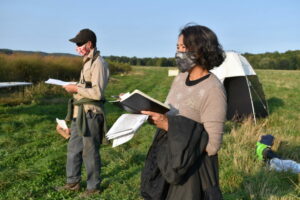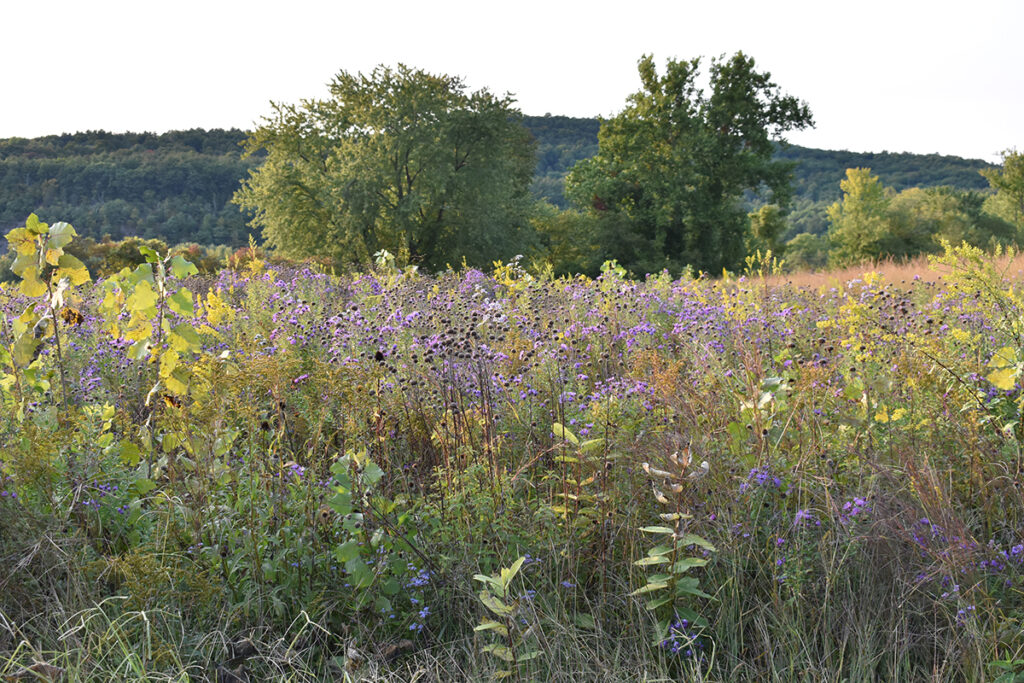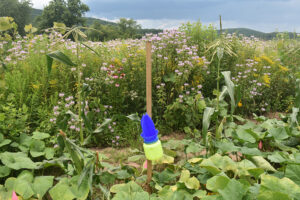NOW INTO THIRD YEAR, RESEARCHERS SHARE RESULTS IN ECOLOGY AND AGRICULTURE
By Amy Wu

Joshua Weber has been tackling the steep learning curve that comes with being a new farmer. Weber is a professor who purchased 35 acres four years ago in Stone Ridge, NY, with the lifelong dream of running his own farm. Four years into this venture, he now has a greenhouse, grows a variety of vegetables, raises chickens and estimates that he’s completed about 60% of the required infrastructure.
There is also the delicate balance between ecology and agriculture that Weber seeks to understand. His farm includes several acres of meadow–but how to manage these sections?
“As I am clearing land I am also laying out fields and [figuring out] how I will rotate the animals and also I need to choose the area that I will leave fallow,” said Weber noting the complexity of the natural systems. This is what drew him to the third Native Meadow Trial Twilight Meeting held on Sept. 22 at the Farm Hub. “I am a big believer in the holistic farm approach. We know enough now how we are destroying the environment. The idea should be that the farm has to be in balance with the landscape,” he said.


The annual event, held at the Farm Hub, is aimed at farmers, conservation professionals, and land managers who are interested in learning how open or underutilized space can be planted to create a beneficial habitat.
While the number of participants was limited this year due to Covid-19, Anne Bloomfield, the Applied Farmscape Ecology Manager, said, “it was important for us to hold this event, even given the additional challenges posed by Covid. Serving the community is crucial to the work of the Program, so creating solutions that allowed us to invite the public onto the farm in a way that felt as safe as possible was really important to us.”
The gathering was led by botanist Claudia Knab-Vispo, Conrad Vispo, wildlife ecologist at Hawthorne Valley Farmscape Ecology Program, and Bloomfield. The attendees rode in hay wagons to the field where the presentations were held. They also had a chance to walk through the trial plots.
All participants wore masks and social distanced and staff helped monitor social distancing.
Research updates

As part of the presentation, the Applied Farmscape Ecology Team shared its most recent findings:
- The Trial served as a platform for the newly formed Applied Farmscape Ecology Program Research Collaborative to work together. Shafiul Chowdhury, associate professor of SUNY New Paltz department of geology, extended soil-water sampling to the trial plots using a Lysimeter to gain a better understanding of what nutrients are flowing out of the soil. Carmen Greenwood, a professor at SUNY Cobleskill, examined the small organisms in the soil.

- Anne Bloomfield shared the symbiotic relationship between birds and the meadows, which can serve as a home and habitat for certain species, particularly during the winter. She pointed to an American Kestrel which happened to be flying above. Bloomfield spoke to participants about the ways in which they can get started identifying birds on their property and managing their land with birds in mind. “The first step is to take some time to observe what birds you have on your land.” Bloomfield said. “You don’t need to know exactly what every bird is, you can begin by simply making observations of the color, size, behavior and habitat of the birds you see and then build on your learning from there.”

- In 2019 the team added vegetables to the meadows’ perimeters, first broccoli and butternut squash, in order to study the impact of insect activity in the meadow plot and on vegetable production. This year they brought back butternut squash and replaced broccoli with corn. Preliminary results show that the corn was most robust in yield and cob size in the field alongside the field known as “Seed Mix A,” which has the highest density of native flower species and a single native grass. The cobs were 15% heavier compared to the ones planted in the two other plots in the trial. In addition, fertilization was higher for corn next to field “A.” There were also more bees around Seed Mix A, a possible result of what Vispo called “skimpy planting.” “Maybe those bees actually played a role in slightly boosting fertilization which, in turn, accounted for the bigger ears,” Vispo posited. “Most corn is wind pollinated, and insect pollination may only be relevant in non-representative light plantings like ours.”
“We’re hoping to take a better look next year,” he added.
Putting learned into practice
After returning to his fledgling farm, Weber reflected on the twilight meeting and said he left with greater confidence in how to manage his own meadows.
“If I manage the meadows that I am going to work with, I don’t think I need to seed them. If you look at Seed Mix A and Seed Mix B and the control plot at the Farm Hub, I kind of already have a mix,” said Weber who had previously planned to purchase a wildflower mix. “I think I’ll also try to manage them by mowing different times of the year.” The control site was left fallow for comparison.
Sue Sie, the head of Backyard to Table, a community organization based in Rhinecliff, NY, and an avid gardener, came to learn how one creates large-scale pollinator habitats and to observe various types of meadows. She plans to share the information with members of her organization.
Looking forward
Before launching the trial, Knab-Vispo had been told by her mentor to expect “the native meadows to sleep during the first year, to creep during the second year, and to leap in their third year.”
This is what happened. Flower abundance in the seeded meadows peaked in the second year, while the seeded plants steadily increased during the first three years.

In the third and fourth years, more species shared the space and produced three smaller peaks of flowers across the season. The researchers expect the meadows to continue to evolve, with short-lived biennials becoming less abundant and long-lived perennials taking their space.
Moving forward, the Applied Farmscape Ecology team plans to leave the meadows standing through this winter to provide food and shelter for birds, small mammals (which in turn are food for raptors), and beneficial insects. Next spring, the plots will get mowed, and the researchers will continue to document their vegetation composition and seasonal flower abundance for several more years to determine if these meadows eventually reach a stable composition with predictable flower abundance.
Check out the Native Meadow Trial Twilight Meeting 2020 photo gallery here.
The Native Meadow Trial launched at the Farm Hub in 2017 in partnership with the Hawthorne Valley Farmscape Ecology Program and the Xerces Society, with the establishment of trial plots on former cornfields. The overall objective is to understand what seed mixes and management systems can produce good habitat for beneficial insects and other wildlife. The Trial plots sit on three one-and-a-half-acre plots of recently tilled and weed-free soil. At two of the sites, seed mixes were planted in varying proportions of grasses to wildflowers, while a third control site was left fallow for comparison. Please see below for the handouts from the Sept. 22 Twilight Meeting:

View handouts in English here
View handouts in Spanish here
Farmscape Ecology Film
The Applied Farmscape Ecology Program at the Farm Hub is the subject of a short film by writer and filmmaker Jon Bowermaster, the founder of Oceans 8 Films. To view the film click here.
